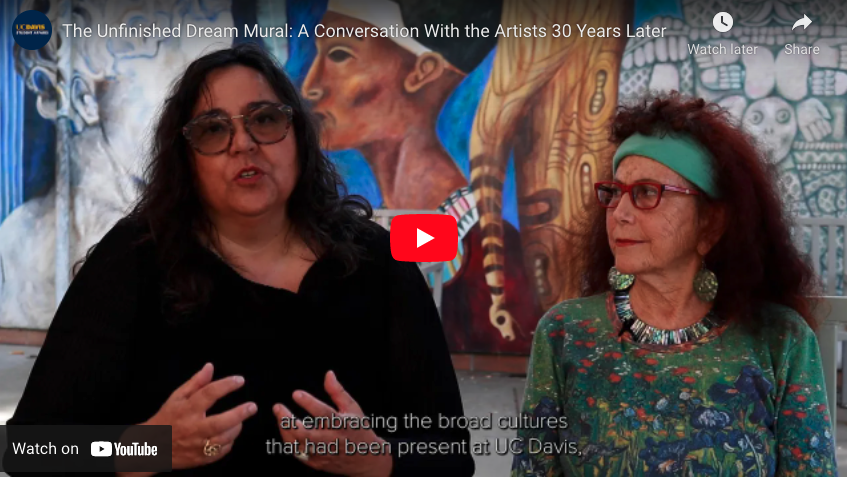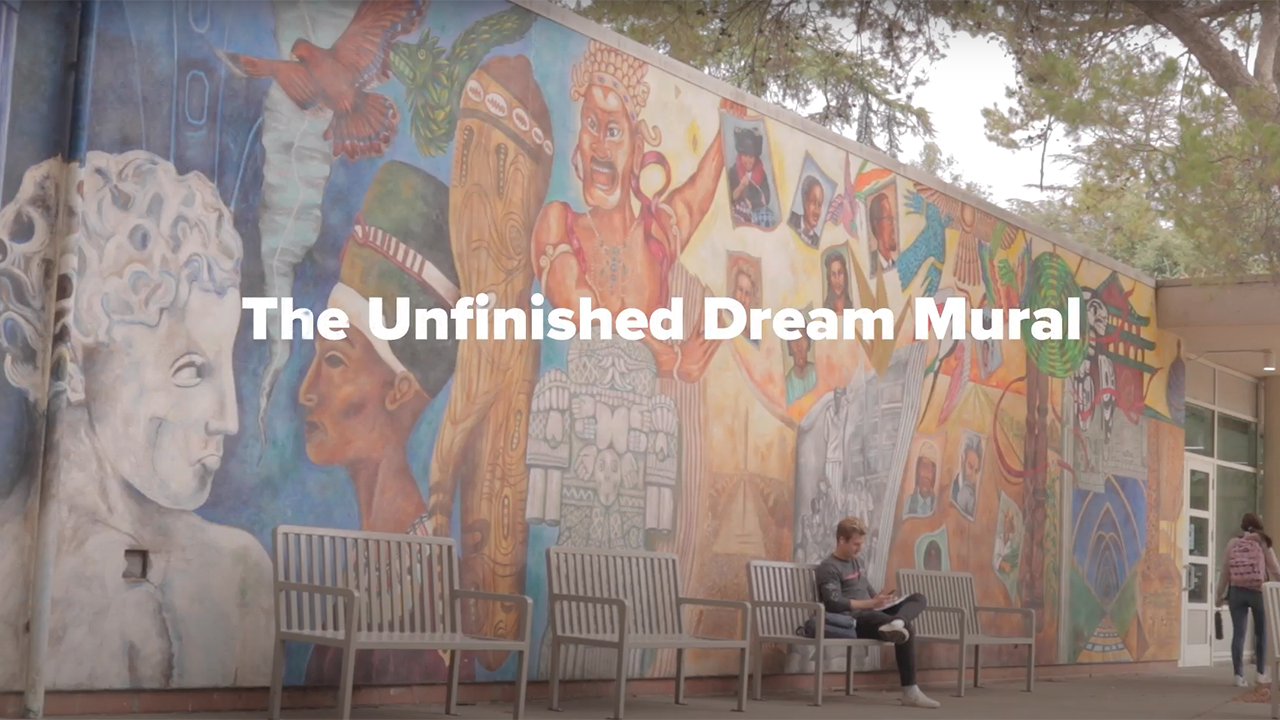Key to the Objects in The Unfinished Dream Mural
Pinch to zoom ?

Key
- Hermes, deity from ancient Greek religion.
- American eagle, representative of Native American culture.
- Quetzalcoatl, the feathered serpent, from pre-Columbian Mexico.
- Nefertiti, Egyptian queen whose reign brought social change.
- Mask, from the Sepik River region of New Guinea.
- Chinese demigod that guards the sacred temple from evil, and representative of ancient Chinese culture.
- Coatlicue, Aztec mother of all gods.
- Mien woman from Southeast Asia sewing traditional embroidery.
- Viola Gregg Liuzzo (1925-65), Italian American woman murdered by the Ku Klux Klan while working for the civil rights movement in Alabama.
- Kintpuash aka Captain Jack (c. 1837–1873), chief of the Modoc, who fought against white colonialists and was hanged at Fort Klamath, California.
- The Civil Rights March on Washington in 1963 where Martin Luther King Jr. made his famous “I Have a Dream” speech.
- The 1990 student hunger strike at UC Davis that established the Cross Cultural Center, among other demands of concern to students of color.
- Don Pedro Albizu Campos (1891-1965), leader of the Puerto Rican Independence Movement.
- Che Guevara (1928-67), Argentine doctor who became a leader of the Cuban Revolution.
- Malcolm X (1925-65) champion of Black liberation who helped to transform the civil rights movement into a force for human rights and self-determination.
- Dolores Huerta, farm worker who became a national leader of the United Farm Workers Union.
- Native American woman of the Karuk Nation wearing a traditional basket hat.
- John Brown (1800-59), an abolitionist who advocated an armed uprising against slavery.
- Harriet Tubman (1822-1913), former slave who became a nurse, scout, and intelligence agent for the Union Army in the South, as well as an abolitionist who guided more than 300 slaves to freedom in the North.
- Asian cane field worker in Hawaii, representative of the myriad of Asian immigrants who came to the U.S. through the islands.
- Chinese embroidered bird.
- Japanese paper crane, a symbol for a world free of nuclear weapons.
- Mystery bird.
- Bird representing the national rights of the Palestinians.
- Zoroastrian bird from Iran.
- Rainbow phoenix, representing everyone and our human right to freedom and equality.
- Pillars from the Dogon of the Guinea coast, West Africa.
- God’s Eye, or prayer wheel, with Peter’s projection world map superimposed, representing the hope for readjustment from Eurocentrism to Multiculturalism.
- Mayan pyramid from pre-Columbian Mexico.
- Roman column.
- Traditional Native American bird motif from the Haida Nation of the northwestern U. S.
- Japanese pagoda.
- Detail from stone relief in the Mayan city of Chichen Itza, (432-1100 A.D.).
- Mezuzah, door ornament containing a blessing for the home, from Jewish culture.
- Gothic European ceiling detail.
- Pacific Island bamboo porch detail.
- Turret from Russia.
- East Indian miniature detail.
- Pakistani door detail.
- Egyptian wall relief.
- Wheel of Life detail, from the national flag of India.
Symbolism in The Unfinished Dream mural
Left Section: A visual rebuttal of the Eurocentric worldview, represented by an ancient Greek marble statue “facing off” with a group of sculptures from Chinese, Egyptian and other non-European cultures.
Middle Section: This section highlights the contributions of groups and individuals toward a more just world. On one side of the book, Martin Luther King Jr. delivers his 1963 “I have a dream” speech, from which the mural took its name. On the other side, the 1990 UC Davis student hunger strike is depicted, which helped advance change on campus and led to the creation of the mural.
Right Section: In this section, architecture and other cultural symbols represent a vision for a world where the brilliance and worth of every culture's contribution is engaged with and celebrated.

WATCH: The Unfinished Dream Mural: A Conversation With the Artists 30 Years Later
During a 2021 visit to campus, Bay Area artists Kim Anno and Miranda Bergman sat down for a discussion about the mural they completed in 1991.

READ: Struggle, Progress and Paint: The Surprising Story of the MU Patio Mural
Trace the mural's connection to a UC Davis student hunger strike, its relationship with other art on campus, and how it continues to resonate and inspire today.